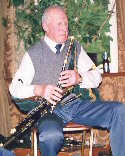Jim Brophy

We were deeply saddened to hear in early January [2002] of the death, at the age of 89, of Jim Brophy, one of the patrons of Na Píobairí Uilleann. Jim was a committed member of the club and took part in all the activities that he could get to. He was one of our founding members at the Bettystown meeting in 1968, and, to the best of my knowledge, never missed coming to the annual tionól. He was a regular performer at the piping marathons and also performed at the Saturday night recitals in Henrietta Street. He was in addition a generous contributor to the funds of the club and to the club’s archive. He loaned several rare 78rpm recordings for copying and also provided some very interesting photographs. The famous picture of Johnny Doran sitting at the caravan in the Green Lanes is widely known only because Jim leant his print to be copied.
He was born into a large and very musical family. His parents were both from Roscrea, co. Tipperary, and came to Dublin just before Jim was born. Jim’s father Pat was a whistle and flute player during his early years in Dublin, and knew very few other musicians. However, when he made the acquaintance of Jim Seery in the late 1920s a door was opened for him into the rich vein of traditional music in the city at that time. The Seerys lived then in Harold’s Cross, close to the homes of two significant piping families, the Rowsomes and the Brogans.
Jim Seery introduced Pat Brophy into this circle by bringing him to the Brogan household where he met pipers such as Jimmie Ennis, John Potts and Pat Ward, among many other musicians. It was in this milieu that Pat developed the love for the pipes which he passed on to Jim and to Jim’s brother Mick. He was directly connected to a very old tradition of piping which could still be discerned over half a century later in Jim’s playing. Pat Mitchell wrote in 1988:
Probably the most memorable session in no. 44 [Parnell Square where NPU once had the use of a small room – ed.] was the night Jim Brophy turned up and, out of practice though he was, played some memorable music on a borrowed set of pipes. The relationship of his piping to Séamus Ennis’ was immediately obvious and it was an education in itself to have the opportunity to compare the two styles and observe both the similarity between them as well as the changes wrought in what must have been the basic piping style of Nicholas Markey who taught both their fathers. (An Píobaire 2.39, May 1988)
By the time he was 15 Jim had progressed from the whistle to the bag and chanter. The first opportunity he got to play a full set was when piper Ned Gorman visited the Brophy house and invited him to try his Willie Rowsome flat set. Jim couldn’t play his father’s set because Pat was a left-handed player. In 1936 he finally bought his own first full set, a Willie Rowsome set which cost him £10. His home became a rendezvous for many of the best musicians of the day, and he recalled visits from Johnny and Felix Doran, Willie Clancy, Andy and Mick Conroy, Jimmie Ennis, Tommy Potts, Matt Kiernan, Dan O’Dowd, Billy Andrews, Tom Mulligan, Breandán Breathnach, Tommy Reck and many more.
Such surroundings certainly had their effect for all of his family of eight brothers and four sisters became involved in music in one way or another. He played live on several occasions on Irish radio, both as a solo performer and as a member of a piping trio with his father and brother. He particularly remembered an occasion in 1951 when the trio played for ten minutes from the studio in the GPO for the sum of £3.
In 1987, along with Dan O’Dowd and Andy Conroy, Jim was made a Patron of Na Píobairí Uilleann, joining the short list of pipers to be so honoured. It was an honour Jim certainly deserved, for his place in the history of piping in Dublin and for his many and varied contributions to the activities of NPU.
In addition to this appreciation of Jim from a piper’s standpoint, I must add something concerning Jim in a more personal way. He used cycle into work or into the Pipers’ Club from his home on Kildare Road, and his route would take him past my home in the Tenters. If travelling to the club he would have a bag and chanter in a case on the back carrier. Whenever we met on the road he would stop and we would have lengthy conversations about what was in the news, the weather, who was on TV the previous night, and so on. I always found him gentle and good-humoured, with never a hard word to say about anyone. I discovered at his funeral that he had devoted a huge part of his spare time to assisting in the upkeep of the church and grounds of the Oblate Fathers in Mount Argus, and that is why he was buried from that church. He had worked as a gardener for the Board of Works, so his work skills would have been very valuable to the congregation there. He was, it seems, very devout. It was not a side of his personality that he thought necessary to reveal to people, but if his religious beliefs were the foundation of his calm and contented attitude to life, then he was a walking advertisement for faith.
He will be very sorely missed. We extend our deepest sympathies to his wife Kitty and to his family and friends.
Terry Moylan (An Píobaire 4.14)